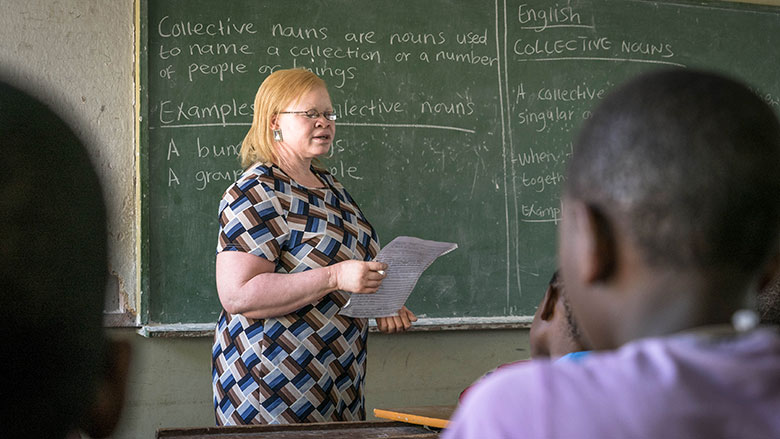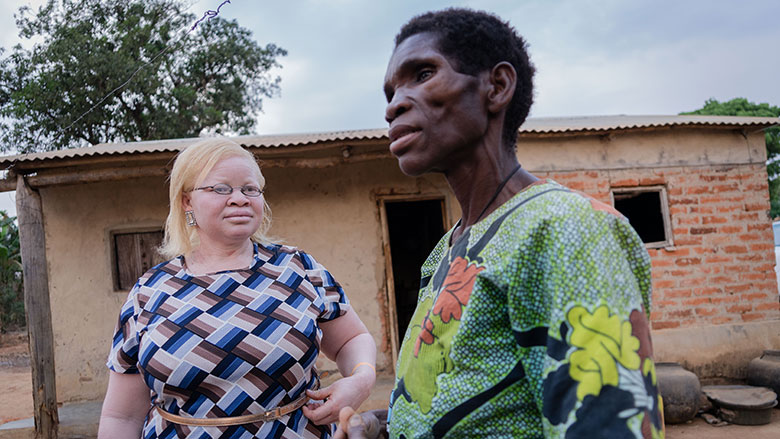Her mother could barely manage to give her children two daily meals. “Due to poverty, I could not go beyond primary school [myself],” Immaculata recalls. “But I understood the value of education, so I encouraged my children to still go to school even on an empty tummy. Now I am a very happy woman, I have my children to lean on. My two girls with albinism are qualified teachers.”
Virginia is her second born. She will complete her training as a secondary school teacher in December, qualifying with a Diploma from a Teacher Training College. In 2011, she qualified as a primary school teacher, and was teaching from 2012–2014. “I am still on my highway to success,” says Virginia. On a scale of 1 to 10 she says she is at 4, her quest for higher education yet to be fulfilled. “From primary school ‘til now, I have worked hard to prove that being a poor person with albinism does not mean I am unable,” she says, recalling how she was denied entry to first grade at a faith-based, mission school. At that time, in 1995, she was told to go to a school for the blind. She did not; her mother could not afford the transport money to send her there.
She was admitted later to her local village primary school, and is pleased the government’s policy has since changed to allow people with disabilities to attend the school nearest them. Immaculata is very proud of her daughters. People with albinism are not as useless as others might think, she says. They can also achieve a lot of good things in life.
Virginia received encouragement and support to pursue a teacher’s career from her widowed mother, Immaculata. Photo: Badre Bahaji/World Bank Personal safety and poverty are greatest risks
The Association of Persons with Albinism in Malawi (APAM) says People with Albinism (PWA) face the constant threat of physical attack. They are less likely to have an education because of their justified fears, and the lack of safety precautions at schools. Their lack of education leads them toward unemployment or to menial jobs, often outdoors where they are more exposed to the sun and at greater risk of developing skin cancers. Many PWAs in Malawi die of skin cancer before the age of 40. The APAM says most also fall into the 52 percent of Malawians who live in poverty.
Against such odds, back in her village, Virginia is a source of inspiration and motivation for teachers and parents alike on why education is important. “In the last five years, no girl has reached Virginia’s level from this primary school,” said Jeremiah Mzunga, headteacher at the school where Virginia studied. “She is a role model and we need many more girls to go to school if this village is to improve.”
Virginia reminisces about learning under a tree while the community constructed two of the three school blocks with funding from the Malawi Social Action Fund financed by the World Bank.
Many people have albinism
Virginia is one of the about 8,000–10,000 people with albinism in Malawi. APAM has registered over 121 attacks on people with albinism since November 2014, including 21 murders. Men were the majority of victims, but 20 percent were women and 8 percent were children.
Despite the recognition of her achievements, Virginia is not immune to the fear this brings. “Much as I am trying to improve my economic and social wellbeing as a free citizen, I pretty much live in fear because of attacks on people with my condition. I have lost trust in fellow beings and that is scary,” she says.
APAM has developed a 2017–2022 strategic plan aimed at ending such violations and helping advance the rights of PWAs. In Malawi, and in Tanzania, the World Bank is also helping raise awareness of albinism.



